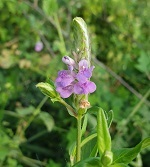n vitro Antioxidant and Hepatoprotective Effect of the Whole Plant of Rungia repens (L.) Nees, Against CCl4 Induced Oxidative Stress in Liver Slice Culture Model
Keywords:
Extracts of Rungia repens, Photochemiluminescence, CCl4, Oxidative Stress, Liver Slice Culture ModelAbstract
Rungia repens (L.) Nees (Family-Acanthaceae) commonly known as ‘Pittapapda’ or ‘Khet papra’ is used in the treatment of various diseases in Indian system of Traditional Medicine. The present study aims to investigate antioxidant and hepatoprotective activity of hexane (RPH), ethanol (RPE) and water extract (RPW) of the whole plant of Rungia repens by employing photochemiluminescence and spectrophotometric methods. The results showed that RPE and RPW significantly inhibited DPPH, NO and SOD radical in dose dependent manner. The trade of phenol content was as: RPH (44 mg PCE/g) < RPW (154 mg PCE/g) < RPE (209 mg PCE/g). Significant correlation was shown by total phenol content and free radical scavenging activity of all three extracts. The hepatoprotective effect was assayed in CCl4-induced cytotoxicity in a liver slice culture model. The results revealed that significant depletion was observed in lactate dehydrogenase, lipid peroxidation, antioxidative enzymes SOD, CAT, and GR on administration of the RPE and RPW or ascorbic acid use as standard in the CCl4- induced cytotoxicity in the liver. Ethanol and water extracts of Rungia repens have prevented significant oxidative liver damage.
References
Valko M, Rhodes CJ, Moncol J, Izakovic M,
Mazur M. Free radical metals and antioxidants
in oxidative stress-inducedcancer. Chem Biol
Interaction. 2006;160:1-40.
Ajila CM, Naidu KA, Bhat UJS, Rao P. Bioactive
compounds and antioxidant potential of mango
peel extract. Food Chem. 2007;105:982-988.
Mahdy KA, Abd-El-Shaheed A, Khadr ME, ElShamy KAI. Antioxidant status and lipid
peroxidation activity in evaluating
hepatocellular damage in children. East Medit
Healt J. 2009;15:842-852.
Desai VG. Aushadhi Sangraha. Bombay,
India: Shri Gajanan Book Depo; 1975.
Kirtikar KP, Basu BD. Indian Medicinal
plants,Vol II. Dehera Dun: Beshen Singh
Mahendra Pal Singh; 1984.
Sivarajan VV, Balachandra I. Ayurvedic Plants
and Their Plant Sources. New Delhi: Oxford
and IBH publishing Co. Ltd.; 1996.
Jung, K-A, Song T-C, Han D, Kim I-H, Kim Y-E
C-H. Lee, Cardiovascular Protective
Properties of Kiwifruit Extracts in vitro. Biol
Pharm Bull. 2005;28:782-1785.
Marcocci L, Maguire JJ, Droy-Lefaix MT,
Parker L. The nitric oxide-scavenging
properties of Ginkgo biloba extract EGB 761.
Biochem Biophys Res Comm. 1994;201:748–
Henry LEA, Halliwell B, Hall DO.. The
Superoxide Dismutase activity of various
photosynthetic organisms measured by a new
and rapid assay technique. FEBS Lett.
;66:303-306.
Miller NJ, Diplock AT, Rice-Evans CA.
Evaluation of the total antioxidant as a marker
of the deterioration of apple juice on storage. J
Agric Food Chem.1995;43:794-1801.
Govindrajan R, Vijayakumar M, Rao CV,
Shirwaikar A, Rawat AKS, Mehrotra S,
Pushpangadan P. Antioxidant Potential of
Anogeissus latifolia. Biol Pharm Bull.
;27:1266-1269.
Slinkard K, Singleton VL. Total phenol
analysis: Automation and comparison with
manual methods. Am J Enol Vitic.
;28:49–55.
Wormser U. Ben ZS. The liver slice system-an
in vitro acute toxicity test for assessment of
hepatotoxins and their antidotes. Toxicol In
Vitro. 1990;4:449-451.
Invittox Protocol No. 42. Liver slice
hepatotoxicity screening system. The
ERGATT/FRAME Data Bank of in vitro
techniques in toxicology. England: INVITTOX;
Renner K, Amberger A, Konwalinka G, Kofler
R, Gnaiger E. Changes of mitochondrial
respiration, mitochondrial content and cell size
after induction of apoptosis in leukemia cells.
Biochem Biophs Acta 2003;1642:115-123.
McMillan DC, Charles BJ, Jollow DJ. Role of
lipid peroxidation in dapsone-induced
hemolytic anemia. J Pharmacol Exp Ther.
;287:868–876.
Marklund S, Marklund G. Involvement of
superoxide anion radical in auto oxidation of
pyrogallol and a convenient assay for
superoxide dismutase. Eur J Biochem.
;47:469-464.
Aebi, H.E. Catalase. In: Bergmeyer HU.
Methods of Enzymatic Analysis, Vol. 3, ed.
GmbH, Weinhein: Verlagchemie; 1983;p. 277-
Ellman GL. Tissue sulfhydryl groups. Arch
Biochem Biophys. 1959;82:70-77.
Bulaj GT, Kortemme T, Goldenberg DP.
Ionization-reactivity relationships for cysteine
thiols in polypeptides. Biochem. 1998;37:8965-
Bradford MM. A rapid sensitive method for the
quantitation of microgram quantities of protein
utilizing the principle of dye binding. Anal
Biochem. 1976;72:248–254.
Magalhaes LM, Segundo MA, Reis S, Lima
LMC. Methodological aspects about in vitro
evaluation of antioxidant properties. Anal Chim
Acta. 2008;61:1-19.
Hall CA, Cuppett SL. Structure-activities of
natural antioxidants. In:, Aruoma OI, Cuppett
SL. Antioxidant Methodology: In vivo and in
vitro Concepts. eds. IL: AOCS Press
Champaign; 1997;p. 141-172.
Frazier JM. In vitro toxicity testing: Application
to Safety evaluation. ed. New York: Marcel
Dekker, Inc; 1992;p. 45.
Naik RS, Mujumdar AM, Ghaskadbi SS.
Protection of liver cells from ethanol
cytotoxicity by curcumin in liver slice culture in
vitro. J Ethnopharmacol. 2004;95:31-37.



